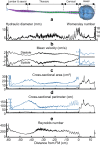In vitro and numerical simulation of blood removal from cerebrospinal fluid: comparison of lumbar drain to Neurapheresis therapy
- PMID: 32178689
- PMCID: PMC7077023
- DOI: 10.1186/s12987-020-00185-5
In vitro and numerical simulation of blood removal from cerebrospinal fluid: comparison of lumbar drain to Neurapheresis therapy
Abstract
Background: Blood removal from cerebrospinal fluid (CSF) in post-subarachnoid hemorrhage patients may reduce the risk of related secondary brain injury. We formulated a computational fluid dynamics (CFD) model to investigate the impact of a dual-lumen catheter-based CSF filtration system, called Neurapheresis™ therapy, on blood removal from CSF compared to lumbar drain.
Methods: A subject-specific multiphase CFD model of CSF system-wide solute transport was constructed based on MRI measurements. The Neurapheresis catheter geometry was added to the model within the spinal subarachnoid space (SAS). Neurapheresis flow aspiration and return rate was 2.0 and 1.8 mL/min, versus 0.2 mL/min drainage for lumbar drain. Blood was modeled as a bulk fluid phase within CSF with a 10% initial tracer concentration and identical viscosity and density as CSF. Subject-specific oscillatory CSF flow was applied at the model inlet. The dura and spinal cord geometry were considered to be stationary. Spatial-temporal tracer concentration was quantified based on time-average steady-streaming velocities throughout the domain under Neurapheresis therapy and lumbar drain. To help verify CFD results, an optically clear in vitro CSF model was constructed with fluorescein used as a blood surrogate. Quantitative comparison of numerical and in vitro results was performed by linear regression of spatial-temporal tracer concentration over 24-h.
Results: After 24-h, tracer concentration was reduced to 4.9% under Neurapheresis therapy compared to 6.5% under lumbar drain. Tracer clearance was most rapid between the catheter aspiration and return ports. Neurapheresis therapy was found to have a greater impact on steady-streaming compared to lumbar drain. Steady-streaming in the cranial SAS was ~ 50× smaller than in the spinal SAS for both cases. CFD results were strongly correlated with the in vitro spatial-temporal tracer concentration under Neurapheresis therapy (R2 = 0.89 with + 2.13% and - 1.93% tracer concentration confidence interval).
Conclusion: A subject-specific CFD model of CSF system-wide solute transport was used to investigate the impact of Neurapheresis therapy on tracer removal from CSF compared to lumbar drain over a 24-h period. Neurapheresis therapy was found to substantially increase tracer clearance compared to lumbar drain. The multiphase CFD results were verified by in vitro fluorescein tracer experiments.
Keywords: Cerebrospinal fluid filtration; Computational fluid dynamics; In-vitro model; Multiphase simulation; Neurapheresis therapy; Subarachnoid hemorrhage.
Conflict of interest statement
BAM has received research funding from Biogen Inc., KBR Wyle, Alcyone Lifesciences Inc., Minnetronix Inc., and Voyager Therapeutics.
Figures







Similar articles
-
Impact of Neurapheresis System on Intrathecal Cerebrospinal Fluid Dynamics: A Computational Fluid Dynamics Study.J Biomech Eng. 2020 Feb 1;142(2):0210061-9. doi: 10.1115/1.4044308. J Biomech Eng. 2020. PMID: 31343659 Free PMC article.
-
Novel Dual Lumen Catheter and Filtration Device for Removal of Subarachnoid hemorrhage: First Case Report.Oper Neurosurg. 2019 May 1;16(5):E148-E153. doi: 10.1093/ons/opy151. Oper Neurosurg. 2019. PMID: 29873785
-
Effects of lumbar drainage on CSF dynamics in subarachnoid hemorrhage condition: A computational study.Comput Biol Med. 2016 Oct 1;77:49-58. doi: 10.1016/j.compbiomed.2016.08.003. Epub 2016 Aug 3. Comput Biol Med. 2016. PMID: 27518326
-
Tunneled lumbar drain. Technical note.J Neurosurg. 2002 Jun;96(6):1130-1. doi: 10.3171/jns.2002.96.6.1130. J Neurosurg. 2002. PMID: 12066917 Review.
-
Red Blood Cells in the Cerebrospinal Fluid Compartment After Subarachnoid Haemorrhage: Significance and Emerging Therapeutic Strategies.Transl Stroke Res. 2025 Feb;16(1):133-146. doi: 10.1007/s12975-024-01238-9. Epub 2024 Feb 29. Transl Stroke Res. 2025. PMID: 38418755 Free PMC article. Review.
Cited by
-
Targeting Hemoglobin to Reduce Delayed Cerebral Ischemia After Subarachnoid Hemorrhage.Transl Stroke Res. 2022 Oct;13(5):725-735. doi: 10.1007/s12975-022-00995-9. Epub 2022 Feb 14. Transl Stroke Res. 2022. PMID: 35157256 Free PMC article. Review.
-
Computational and biological modeling of IGF1R inhibition for multifocal medulloblastoma.Commun Med (Lond). 2025 May 28;5(1):206. doi: 10.1038/s43856-025-00925-4. Commun Med (Lond). 2025. PMID: 40437228 Free PMC article.
-
Evaluating the effect of injection protocols on intrathecal solute dispersion in non-human primates: an in vitro study using a cynomolgus cerebrospinal fluid system.Fluids Barriers CNS. 2024 Jul 26;21(1):61. doi: 10.1186/s12987-024-00556-2. Fluids Barriers CNS. 2024. PMID: 39061067 Free PMC article.
-
Computational fluid dynamics model to predict the dynamical behavior of the cerebrospinal fluid through implementation of physiological boundary conditions.Front Bioeng Biotechnol. 2022 Nov 22;10:1040517. doi: 10.3389/fbioe.2022.1040517. eCollection 2022. Front Bioeng Biotechnol. 2022. PMID: 36483773 Free PMC article.
-
Prevention of Delayed Cerebral Ischemia After Aneurysmal Subarachnoid Hemorrhage-Summary of Existing Clinical Evidence.Transl Stroke Res. 2025 Feb;16(1):2-17. doi: 10.1007/s12975-024-01292-3. Epub 2024 Aug 30. Transl Stroke Res. 2025. PMID: 39212835 Review.
References
Publication types
MeSH terms
Grants and funding
LinkOut - more resources
Full Text Sources
Medical
Miscellaneous

